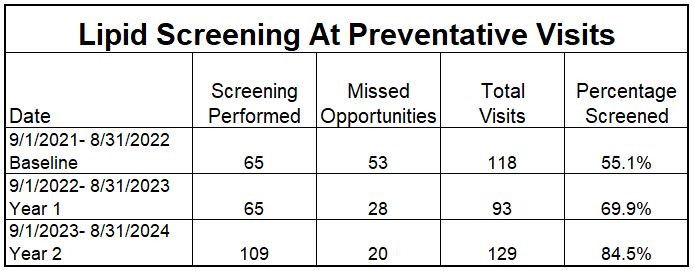Quality Improvement/Patient Safety 6
Session: Quality Improvement/Patient Safety 6
491 - Lipid Screening in a Young Adult Population at a Large Urban Academic Medical Center
Saturday, April 26, 2025
2:30pm - 4:45pm HST
Publication Number: 491.5655
Paul Broker, UT Southwestern Medical Center Dallas, Dallas, TX, United States; Jason Newman, University of Texas Southwestern Medical School, Colleyville, TX, United States; Suraj Rama, University of Texas Southwestern Medical School, Dallas, TX, United States; Samarth Shrivastava, University of Texas Southwestern Medical School, Dallas, TX, United States

Paul Broker, MD (he/him/his)
Assistant Professor of Internal Medicine-Pediatrics
UT Southwestern Medical Center Dallas
Dallas, Texas, United States
Presenting Author(s)
Background: Ischemic cardiovascular disease is the leading cause of mortality in the United States. Identification of at-risk populations is necessary to implement targeted management. The American Academy of Pediatrics (AAP) recommends universal hyperlipidemia screening of young adults ages 17-21 years; however, despite national recommendations routine lipid screening has historically remained lower than recommended.
Objective: At our General Internal Medicine-Pediatrics clinic based at a large urban academic medical center, physician adherence to AAP-recommended universal hyperlipidemia screening of young adults was 55.1 percent. Our goal is to increase routine lipid screening for patients 17-21 years seen in our Internal Medicine-Pediatrics Clinic at preventive visits from our baseline rate of 55.1 to 85 percent or greater by August 2024.
Design/Methods: Education was provided to the clinic staff and providers on the AAP and national guidelines for hyperlipidemia screening for ages 17–21 years old. A health maintenance topic in our electronic medical record Epic was also created to alert providers when a lipid panel was required at the appropriate age range. Measurement of a one-time routine lipid panel ordered and/or completed for 17–21-year-old patients who had a preventive exam during the measurement period was performed.
Results: Data was obtained, tracked, and analyzed for percentage of lipid screening ordered and/or resulted at preventive visits for patients meeting the age criteria of 17-21 years with needing a one-time lipid screening. Screening results for each time interval are as follows: 9/1/2021- 8/31/2022 baseline without intervention was 55.1%; 9/1/2022- 8/31/2023 for year 1 of implementation was 69.9%; 9/1/2023- 8/31/2024 for year 2 of implementation was 84.5%.
Conclusion(s): Prevention of coronary artery disease through LDL lowering therapies reduces mortality. Described interventions proved clinically significant. Adherence among our physicians to screening guidelines increased from 55.1 to 84.5 percent. Given the incidence of familial hypercholesterolemia and the overall increasing incidence of metabolic syndrome, this quality improvement project shows a pathway to improvement for early detection of hyperlipidemia and related disorders. Routine lipid screening at this age allows for a secondary gain of early supportive discussion regarding lifestyle changes and if necessary, initiation of medication management.
Run Chart For Lipid Screenings At Preventive Visits
 Figure 1. Run chart showing lipid screenings ordered and/or resulted overtime at preventive visits, along with demonstration of clinic-based goals and timing of Plan-Do-Study-Act cycle implementation.
Figure 1. Run chart showing lipid screenings ordered and/or resulted overtime at preventive visits, along with demonstration of clinic-based goals and timing of Plan-Do-Study-Act cycle implementation. Table Data for Lipid Screening At Preventive Visits
 Table 1. Representation per date range of lipid screenings ordered and/or performed, missed opportunities for screening, total potential visits for screening, and percentage screened.
Table 1. Representation per date range of lipid screenings ordered and/or performed, missed opportunities for screening, total potential visits for screening, and percentage screened. Run Chart For Lipid Screenings At Preventive Visits
 Figure 1. Run chart showing lipid screenings ordered and/or resulted overtime at preventive visits, along with demonstration of clinic-based goals and timing of Plan-Do-Study-Act cycle implementation.
Figure 1. Run chart showing lipid screenings ordered and/or resulted overtime at preventive visits, along with demonstration of clinic-based goals and timing of Plan-Do-Study-Act cycle implementation. Table Data for Lipid Screening At Preventive Visits
 Table 1. Representation per date range of lipid screenings ordered and/or performed, missed opportunities for screening, total potential visits for screening, and percentage screened.
Table 1. Representation per date range of lipid screenings ordered and/or performed, missed opportunities for screening, total potential visits for screening, and percentage screened. 

